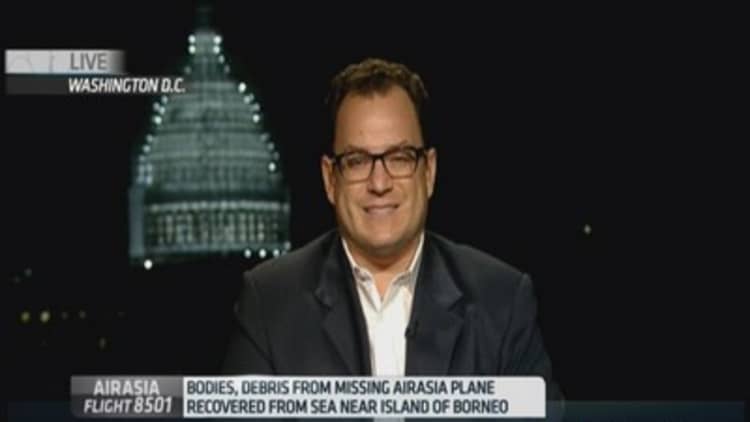
The bulk of the missing AirAsia jet may be on the floor of the Java Sea, according to sonar images obtained by Indonesia search and rescue teams, which could indicate the aircraft hit the sea bed intact.
The image suggests the jet lies around 3.2-3.5 kilometers from where debris from the plane was found on Tuesday, according to the Wall Street Journal. Various reports put the site at between 24-50 meters under water.
Aviation Consultants International CEO Hugh Ritchie told CNBC that the relatively contained debris field and the sonar image suggested the aircraft was caught in bad weather.
"The aircraft got caught in a severe thunderstorm, it didn't break up but it lost its capacity aerodynamically to fly and crashed into the sea...(It) would suggest it was intact when it hit the water and that would explain why most of the debris is in close proximity," he said.
Seventh body found

Seven bodies have been recovered from the sea, some of them fully clothed. One person was wearing a life jacket, according to media reports, potentially indicating that the plane was intact when it hit the water. Other reports suggested that a flight attendant was found still wearing her uniform for Malaysian budget airline AirAsia.
AirAsia Flight QZ8501 lost contact with traffic control on December 28, on a flight to Singapore from Surabaya, Indonesia.
The plane, an Airbus A320-200, was carrying 162 people, including 155 passengers—137 adults, 17 children and 1 infant— and two pilots, four members of cabin crew and one engineer.
Most of the next of kin in Singapore have flown to Surabaya, according to Changi Airport Group.

Even if searchers find a relatively intact plane body, the rest of the recovery may not be easy.
"It's a painstaking thing to find all the pieces of the wreckage and then put it back together," Keith McGuire, instructor at Viterbi Aviation Safety & Security program at the University of Southern California, told CNBC.
"I would be surprised if they recover all of the wreckage," he said, citing experience with previous under-water aircraft searches.
He said searchers would likely try to find the most important components, including the black boxes—aircraft's electronic recording devices.
However, these will not necessarily provide answers.
"Everyone thinks the black box will tell them everything they need to know about the accident and that isn't quite true. There are other aspects of the investigation that need to be looked at. Human factors for example," McGuire said.
Read MoreWhy we still can't track an airplane
The search has been hampered by poor weather conditions. The region is in the midst of its rainy season and seas have been rough.

